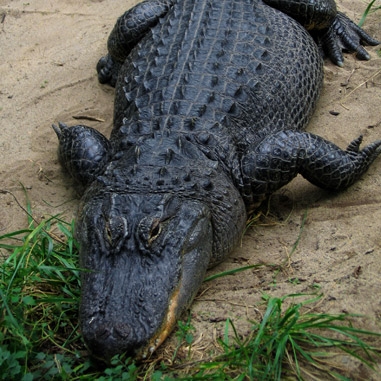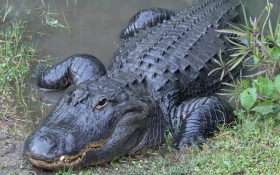
American Alligator
Alligator mississippiensis
Animal Behavior: The American alligator is the largest reptile in the United States. While it is quite large, its limbs are relatively short and thick to help it swim. Another distinguishing feature of the American alligator is its jaw structure and overall shape of the rostrum. As compared to the pointed shape of the crocodile snout, the snout of the American alligator is round. Because the upper jaw is larger than the lower jaw, when an alligator closes its mouth, no teeth are visible, as compared to the visibility of teeth when a crocodile has a closed mouth. The American alligator is a homodont and has approximately 80 teeth of all the same size, but because the teeth break, get worn down, or fall out, the teeth are replaced rapidly throughout its lifetime.
Eating Habits: The diet of the American alligator is varied. Two main factors that contribute to the food habits of the American alligator are its size and stage of development. The bigger the alligator, the more it can eat in terms of volume and the bigger animals it can eat. Even in the adult stage, size of the adult affects what they eat larger adults consume larger prey in greater volume. During the juvenile life stage, an alligator eats mostly small fish, insects, and invertebrates. As the alligator matures, it starts to eat larger mammals. As an adult, an alligator can also eat reptiles and birds.
Range: American Alligators are crocodilians native to North America and is the crocodilian with the northernmost distribution worldwide. These creatures are found as far north as the tidal regions in North Carolina, to as far south as every county in Florida, and as far west as central Texas. Other states where the American alligator can be found are South Carolina, Georgia, Alabama, Mississippi, Louisiana, Arkansas, and Oklahoma.
Conservation Efforts: Inadvertently, humans kill alligators by running over them with vehicles, catching them in nets and trout-lines, and striking them with boats in shallow waterways. Along with hunting, these threats contributed to the American alligators being listed as federally endangered.
Animal Facts: It is estimated that an American alligator can typically live 20-30 years in the wild, whereas in captivity, it can live approximately 50 years. The longest recorded time for an alligator living in the wild was 56 years, and longest lifespan recorded in captivity was 73.1 years.
